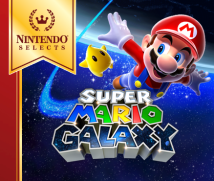1. Why Use an Orchestra?
Now that I have returned to the Kyoto headquarters, I would like to interview the staff members that were in charge of creating the sound of Super Mario Galaxy. Let’s start with introductions and begin with (Koji) Kondo-san, who is well-known for his work in the Mario and Zelda games.
I am Kondo, from the Sound Group of EAD (Entertainment Analysis and Development). Since this game was developed in the EAD Tokyo office, I joined the project as an adviser to ensure that the sound for the game would have the “Essence of Mario”. In addition, I composed four of the pieces for this new Mario game.
I am Yokota from EAD Tokyo. I was in charge of the composition and arrangement for almost all of the music. We recorded the music using a live orchestra, and so I also worked on arranging the music for the orchestra recording.
Hi, I am Kawamura of EAD Tokyo. For this game, I was responsible for sound-related programming, and creating the sound effects.
Yokota-san just mentioned that we used a live orchestra for recording the music.
That’s right. We actually recorded a video of how things went during the recording. Please, take a look.
The music makes you anticipate the great adventure to come. The expression Miyamoto-san has on his face in the video is not one you see him with very often.
After the recording, I heard him say “We were right to do that!”
This time, we recorded with an orchestra of about 50 or so members. Of course, they were not very good at first because they were playing music they’d never heard before, and they are also seeing the score for the first time. But as the day went on, their performance improved dramatically, and the process of recording each track in its final form was actually a very fast one. This surprised Miyamoto-san, who was glued to the glass wall looking at them from the other side. He was saying “So, sound is something that really changes too!”
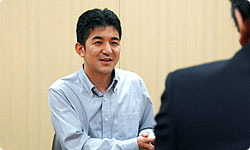
I am sure that experience will be brought to life in Wii Music (name not final)1. Anything that Miyamoto-san finds interesting will always end up in the form of a game! (laughs) 1 Wii Music (name not final) is a title that is scheduled for release in Japan 2008 on Wii in which the Wii Remote will be used to play a variety of musical instruments.

(laughs)
So, how did you end up deciding to use a live orchestra?
Every time I saw Miyamoto-san, I would always ask him, “How about using an orchestra?”
And you kept asking him until he answered “Okay”! (laughs)
That pretty much sums it up! (laughs) To record using an orchestra is not cheap, and we also had this fundamental concern as to whether using an orchestrated soundtrack would fit the rhythm of a Mario game. The sound of recent video game music is so high-quality and crystal clear, it's almost as if you're listening to a music CD you buy at a music shop. But I do question whether that kind of sound is always necessarily suited to the game.
It almost seems like while you're playing the game, the music is coming from a CD player, and not from the game console and it feels like you are obligated to play the game in time to the music. For that reason, Nintendo has only used a live orchestral soundtrack on a few occasions in the past.
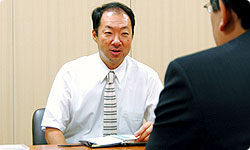
I didn't want to use an orchestra just for the sake of it. I even thought that although you may be able to make the scale of the game seem more epic by using music from a live orchestral recording, it could end up sacrificing the game's rhythm and have the opposite of the intended effect. But when we made the music stream during game play... I'm sorry, does everyone know what I mean by streaming music?
That's when the game just plays pre-recorded music without it being synchronised to what is going on in the game.
Thank you! (laugh) In this game, even though we decided to stream the soundtrack, the game's rhythm improved, and the players are able to focus better on the game play. Of course, there was a lot of hard work involved behind the scenes.
And that's where Kawamura-san, the programmer comes in. What kind of things did you do?
Before working on Super Mario Galaxy, I had already been experimenting with getting sound effects to play in sync with the background music automatically. For instance, in Wind Waker2, a sound effect will ring in sync with the music when you hit an enemy, and in Jungle Beat, the sound is played in sync with the music every time you jump. For this game, we wanted to take that system a step further; we experimented to find a way to make that system work with streamed music. And when we got a hold of the raw orchestra data and put it into the game, we thought "This is going to work!" 2 Wind Waker = The Legend of Zelda: The Wind Waker is an action adventure game released for the Nintendo GameCube in Europe in May 2003.

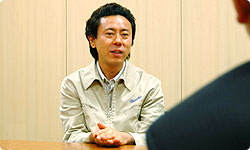
So you made the game read the data waveform of the streaming music so that it could trigger the sound effects at the correct time?
This gets a little technical; the game synchronises MIDI3 data with the streaming data, and this is used to process the sound effects at the right time. When Mario shoots off from the Sling Star, for example, harp music plays as a sound effect. If you listen carefully, this harp will sound in perfect timing with the background music. This kind of technique rarely gets noticed however. 3 The MIDI (Musical Instrument Digital Interface) format allows the exchange of sound data between digital musical devices such as synthesisers, samplers and sequencers.
It's as if the melody from the harp is a totally natural part of the background music.
To make this possible, we really demanded a lot from the members of the orchestra. Music from the orchestra will play at the tempo that had been set in the studio, which usually is just a little off from the tempo of Mario running. I absolutely wanted to avoid using music that simply played regardless of the game's tempo, so I got this device that works in a similar way to a metronome, where it would tick at the exact tempo with the game. I asked the orchestra, "Please perform at exactly the same rhythm as this."
Normally, an orchestra would not use anything like a metronome when they perform.
To enhance the live feel of the orchestra, it's best to have as few of those kinds of restrictions as possible. But for this recording, we gathered the type of musician who can still perform at their best under those circumstances. After the recording, when they told me "It was great fun," I felt so relieved!
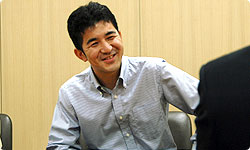
But even when you had decided to use an orchestra, you must not have been able to do the recording until the contents of the game were finalised.
Right! That was the toughest part!
(laughs)
It really felt as if we were walking on a tightrope. We weren't able to schedule the recording dates until Miyamoto-san gave us the green light. So we recorded all 28 tracks, constantly checking with him for each track, asking "Is this music okay for this stage?" so that we could be 100% sure that this music was really ready to be used.
It must not have been easy to arrange all 28 tracks.
It was tough, but since I was the one that wanted to do this...
You said “Please leave it to me” and had your budget approved; this was something you had to take charge of yourself! (laughs)
Miyamoto-san told me "It was really hard getting the budget approved. I'm expecting a lot from this." That put a lot of pressure on me! (laughs)
